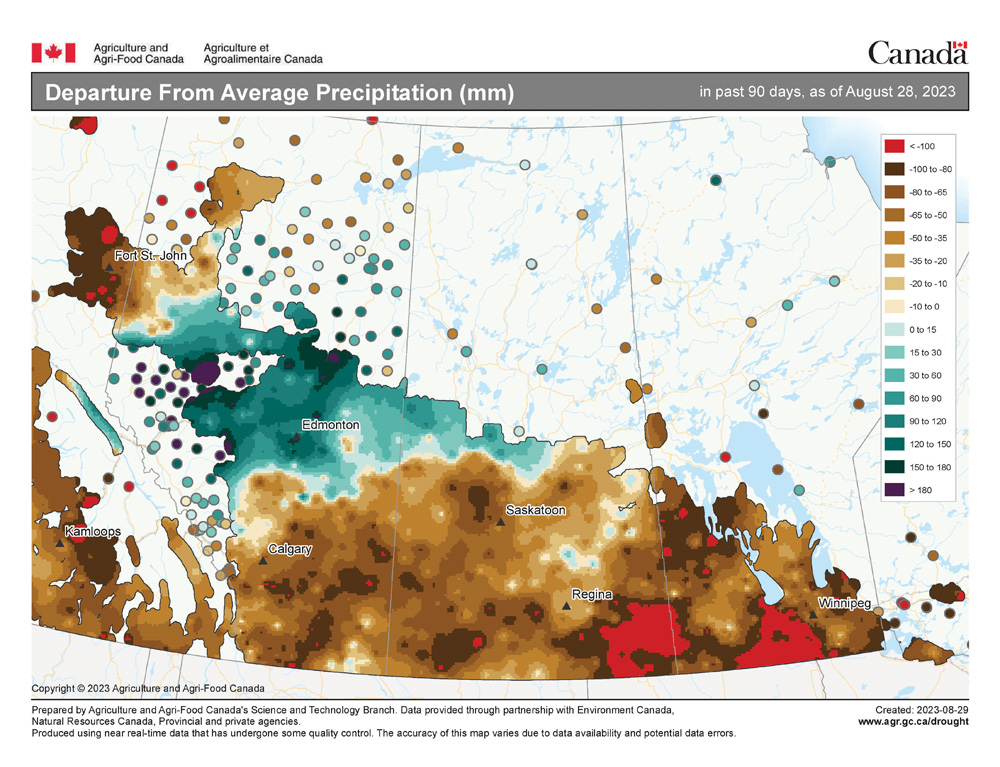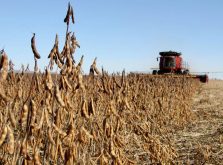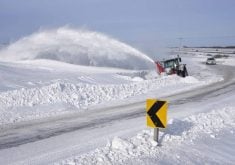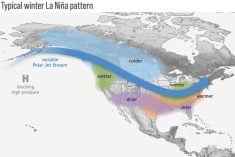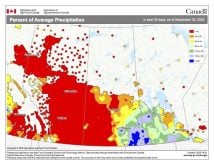Summer 2023 has come and gone, and weather-wise, it was a bit of a mixed bag across the Prairies. Large parts were dry, some regions wet, while a few lucky locations received the perfect amount of precipitation.
Summer started off hot, then went cool over eastern regions before turning back to average by the end. To the west, warm summer temperatures started early and just kept going.
Let’s look at August weather in the west. Alberta saw another month of above-average temperatures, with both Calgary and Edmonton recording mean monthly temperatures of around 18 C, which is two to three degrees above average.
Read Also

October rain recharges Manitoba soils
Daniel Bezte looks back on October weather on the Prairies and looks ahead to see whether there’s any consensus for this winter’s weather.
Peace River recorded a mean monthly temperature of 16 C, about one degree warmer than average. Precipitation was below average in the south and north, with Calgary reporting around 25 millimetres and Peace River reporting about 35 mm. Central regions saw near- to above-average amounts with Edmonton reporting 58 mm.
Saskatchewan saw similar temperatures as Alberta, with both Regina and Saskatoon recording mean monthly temperatures in August around 18 C. This comes in near to slightly above the long-term average for the month. Precipitation amounts were slightly below average, with Regina reporting 35 mm and Saskatoon reporting 38 mm.
In Manitoba, the consistent 18 C mean monthly temperatures seen across the Prairies continued with Winnipeg, Brandon and Dauphin all coming within 0.5 C of 18 C.
Winnipeg’s 40 mm of rain and Brandon’s 27 mm were both well below the average for August. Dauphin reported 67 mm of rainfall for the month, thanks to a heavy downpour on Aug. 10-11, so it was slightly above average for the month.
Overall, August saw near-average temperatures in the east, warming to above-average as you travel west. Precipitation was below average in most locations, with a few areas seeing near average.
Looking back at the different long-range forecasts, the winner is the National Oceanic and Atmospheric Administration, with its forecast of average temperatures in most of the Prairies, Alberta with above-average temperatures, and a precipitation forecast of near-average amounts.
The summer that was
Let’s do a quick summary of the whole summer, June to the end of August. Alberta saw a consistently warm summer with all three months above average. Edmonton reported a mean monthly temperature of 18 C, about 3 C warmer than average. Calgary was the next warmest with a mean summer temperature of 17.5 C, about 2 C warmer than average. Peace River reported a mean summer temperature of 16.5 C, about 1 C warmer than average.
Precipitation over the summer was below average in Calgary and Peace River and above average in Edmonton, thanks to a very wet June.
Saskatchewan also saw warmer than average temperatures this summer but not to the extent of Alberta. Saskatoon recorded a mean summer temperature of 18 C. This was about 1 C above average. Regina was a little warmer with a mean summer temperature of 19 C, which was also about 1 C warmer than average. Precipitation was below average in both locations.
Across agricultural Manitoba, mean summer temperatures were a little above average, thanks mostly to an extremely warm June. Both Brandon and Dauphin recorded mean summer temperatures — drum roll, please — right around 18 C, which is about 0.5 C warmer than average.
Winnipeg was a little warmer, with a mean summer temperature of 19 C, which was also around 0.5 C warmer than average. All three Manitoba locations reported below average precipitation for the summer.
Overall, the summer of 2023 saw near to slightly above average temperatures in the east thanks to a very warm June, with temperatures warming to well above average moving west. For most regions, this past summer was dry, with a large portion of the Prairies reporting below-average precipitation.
Looking ahead
Now for the latest medium- to long-range weather forecasts, starting with the almanacs. The Old Farmer’s Almanac calls for near average temperatures in September along with above-average precipitation. This transitions into above-average temperatures and near-average precipitation in October.
The Canadian Farmers’ Almanac calls for below-average temperatures and above-average precipitation in both September and October. It mentions showers, unsettled and wet weather, along with cool or chilly conditions.
NOAA’s three-month outlook calls for near-average temperatures in Manitoba and Saskatchewan and above-average temperatures in Alberta. Its precipitation outlook calls for equal chances of either above or below, which likely means near-average. Parts of Alberta have a greater chance of below-average amounts.
The latest CFS weather model calls for above-average temperatures this fall, with the best chances across Saskatchewan and Manitoba. Its precipitation forecast calls for above-average amounts across southern Manitoba and central Alberta with near-average amounts elsewhere. The CanSIPS model calls for above-average temperatures and near-average precipitation this fall.
The European model calls for above-average temperatures and near-average precipitation, with the eastern Prairies possibly seeing above-average precipitation in September.
My take on this: with the latest El Nino advisory calling for a 95 per cent chance of the current El Nino conditions continuing into the fall and winter, I lean toward a warmer than average fall with near to below average precipitation.


